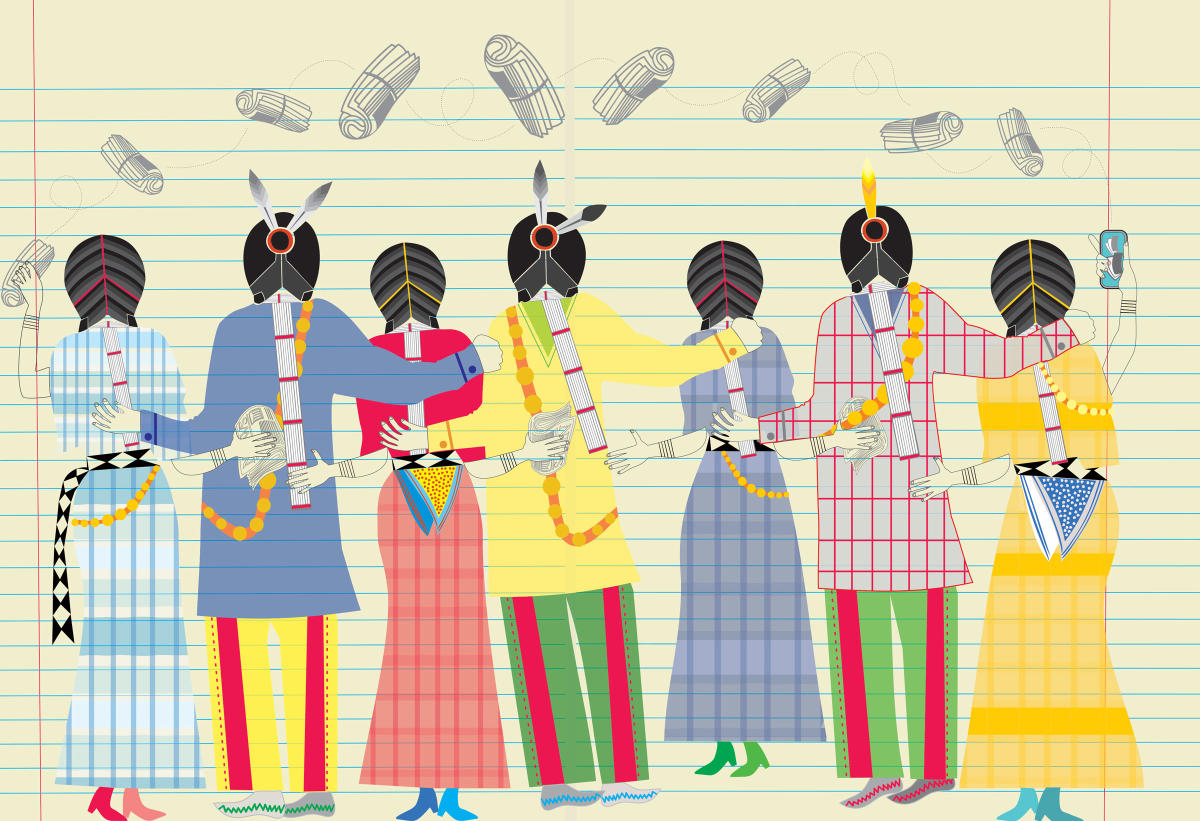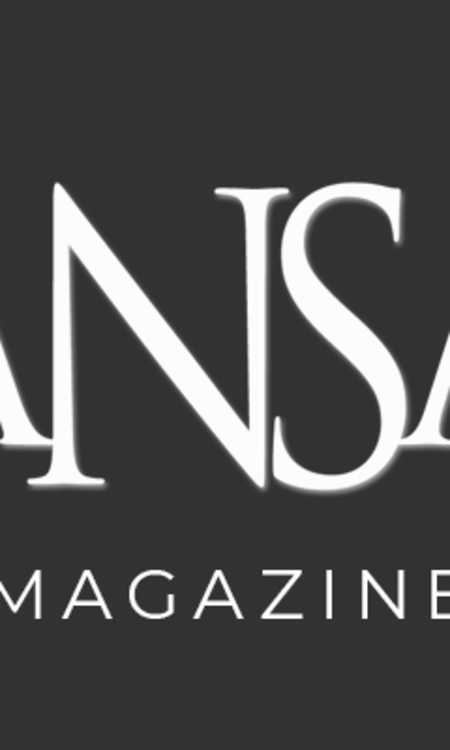 Illustration by Lana Grove
Illustration by Lana Grove
A few years ago, I was discussing my Osage (𐓷𐓘𐓻𐓘𐓻𐓟) citizenship and family history with someone I had recently met in the Johnson County area. When she found out I was Osage, she furrowed her brow and said, “Oh, I thought the Osage were extinct?” No. We are not. We are still here. This interaction resurfaced an important question for me as a Native educator, “What are people learning about Indigenous peoples of Kansas?”
We have a systemic issue in Kansas curricular infrastructures and teaching norms. We need to understand the problem. Research about the representation of Indigenous peoples in curricula across the nation tells us that a key issue with our state standards is that 87% of all standards about Native peoples are set in a pre-1900 context. Our Kansas social studies standards fall into this same trap. Many people in Kansas today do not realize that the Kaánze (Kaw/Kanza) people, for which the state is named, are still a nation and community headquartered in Oklahoma where they were forcibly removed in 1871. The removal of Native nations—both physically during Kansas statehood and again in Kansas curricula—has removed important Indigenous contexts from classrooms, and these erasures are problematic for student learning. Most students leave Kansas schools entirely unaware that there are four separate nations in their state who have federally recognized authority to self-govern: the mshkoteni bodwewadmi (Prairie Band Potawatomi Nation), the Kiikaapoi (Kickapoo Tribe of Kansas), the Ne ma ha ha ki (Sac and Fox Nation of Missouri in Kansas and Nebraska), and the Baxoje (Iowa Tribe of Kansas and Nebraska). In a 2021 study published in Theory & Research in Social Education, Kansas is named among 14 states that do not include any standards about Indigenous nationhood in their government and civics curricula.
Moving Forward
There are a number of states modeling how to improve learning about, for, and with Indigenous peoples, such as Washington, Montana, Wisconsin, Minnesota, and North Dakota, among others. These states have passed new laws or developed policies that overhaul their state curricula, mandate learning about Indigenous peoples in educator training programs, engage in education partnership-building with Native nations, and more. Long term, Kansas can follow their lead, but educators do not need to wait for massive change at the state level to improve their teaching and learning about Indigenous peoples. Here are some initial practical strategies that most Kansas educators can address easily.
Connect to the Present
When teaching about Indigenous peoples, educators can connect lessons to how Native peoples and nations still exist in the present. Organizations such as IllumiNative offer resources for teachers to help make these connections, but they can also find the current website of relevant nations, click on their “Government,” “History,” or “Culture” tabs and connect lessons to the content provided, some of which includes lesson plans. This practice of recognition also means that, as educators, we need to be conscious of our language, especially how we often refer to Native peoples in the past tense. Our goal is to fight erasure and provide Native and non-Native students with relevant, current information about contemporary Indigenous nations and peoples. We can do better.
Start Local
There are over 570 federally recognized tribes, and no educator can become an expert on all of them because each American Indian nation represents a unique government, history, language, etc. Kansas teachers and administrators can begin to educate themselves on local Indigenous peoples by focusing on three layers: the original Indigenous peoples of Kansas, those who moved through during Indian removal, and those still here. Specifically, this would mean visiting the websites of the Kaánze (Kaw/Kansa), 𐓷𐓘𐓻𐓘𐓻𐓟 (Osage), and Pâri (Pawnee) nations who were in the Eastern part of the state, and the Tsistsistas and Hinono’ei (Cheyenne and Arapaho), Gáuigú (Kiowa), and Nmn (Comanche) from the West, among others. Then, there were more than 15 nations that were moved through Kansas during Indian removal in the early to mid-1800s from the eastern United States, including the Saawanooki (Shawnee), Waⁿdát (Wyandotte), Myaamia (Miami), Lenape (Delaware), Adawe (Ottawa), and Peewaalia (Peoria), among others.
After these forced removals in latter half of the 1800s, mostly to what is now Oklahoma, four Native nations remain in Kansas (mshkoteni bodwewadmi, Kiikaapoi, Ne ma ha ha ki, and Baxoje), and many diasporic citizens of previously mentioned nations still reside in Kansas. In other words, while many Native nations with history in Kansas are now headquartered in Oklahoma, there are many citizens of those nations—and even some remaining land allotments—that still reside in this state. While all Indigenous nations deserve visibility as part of the statewide curriculum, teachers and teacher training can focus on Native nations most relevant to the particular land base of their school. For example, in Manhattan, USD 383 is on land ceded through the Kaw Treaty of 1825.
Recognize Governments
A third strategy is to affirm the sovereignty of Native nations by including them in any lessons about local, state, and national governments. Once again, details can be found on the websites of Native nations, and many educators might be surprised to know that many of these nations share similar government structures as our local, state and federal governments, such as a council systems or three-branch constitutional systems with legislative, executive and judicial functions.
Move Beyond Plymouth Rock and Thanksgiving
A fourth educational strategy is to expand when and what we teach about Indigenous peoples and nations. While teaching a more accurate version of events such as Thanksgiving should be a priority, we also need to create lessons beyond and outside Plymouth Rock, Thanksgiving and Native American Heritage Month. Relatedly, we can also think beyond cultural exhibitions, museum exhibit lessons, and what I refer to as “drum and feather” contexts in which Indigenous people are seen only in the past or, if in the present, dancing in regalia in the school gym. This is not to critique such integrations of cultural awareness, which are still a positive, but we need to build on these efforts and think more broadly about educational content focused on Indigenous peoples. To challenge the status quo, we need to introduce students to substantive topics related to the complex lived experiences and current issues facing Native peoples. This can be done by exploring the story of Iⁿ ‘zhúje ‘waxóbe, the big red sacred prayer rock in Lawrence that is being returned to the Kaw Nation, or by looking at how McGirt v. Oklahoma is unfolding in the wake of such a landmark Supreme Court decision. Educators should also consider teaching about missing and murdered Indigenous women (MMIW), creating lessons that creatively unpack short video clips found in Rutherford Falls or Reservation Dogs, or reading children’s books written by native authors from Kansas who represent various tribal backgrounds like Jimmy Beason (𐓷𐓘𐓻𐓘𐓻𐓟/Osage) or Sharice Davids (Hock/Ho-Chunk Nation). All of these strategies move us past outdated and narrow learning contexts.
Examine Sources
While there is much to suggest, the final strategy I offer is to be mindful of your sources. Look at the dates of secondary material and ask critical questions about who is representing Native people in books, media, guest appearances, etc. Debbie Reese’s American Indians in Children’s Literature blog is an excellent resource to help choose appropriate American Indian–themed books for children and young adults. There is a long history of non-Native people misappropriating, misrepresenting, and profiting from Indigenous peoples’ customs, stories, and traditions. Thus, as we move toward better inclusion, we need to carefully reflect on what Native-themed content is being brought into student learning environments and who created it. For example, prioritizing books by Native authors such as Beason and Davids helps address this issue. In other words, teachers must become critical consumers of media while reflecting on many of the points I have outlined, and do more than just grab a Native-themed book off the shelf and read it to the class.
Overall, we can do better, and these are logical starting points for educators to explore as we work to improve learning about, for, and with Native peoples and nations.
—Alex Red Corn, EdD, is the executive director for the Kansas Association of Native American Education, an assistant professor of educational leadership, and coordinator for Indigenous partnerships in the College of Education at Kansas State University.
Ways to Stay Connected
More Articles You'll Enjoy
Quantrill's Raid Survivor: Kate Doane Earle Riggs
Jun 27, 2024Kate Doane Earle Riggs Bushwhacker Beater Kate Doane Earle was born in Pittsburgh, Pennsylvania, on… Read More
Quantrill's Raid Survivor: Elizabeth Margaret Acheson Fisher
Jun 27, 2024Elizabeth Margaret Acheson Fisher Free Stater and Rescuer Elizabeth Margaret Acheson was born in New… Read More
Notorious: Rebels for a Good Cause
Jun 26, 2024Artwork: Torren Thomas In the late 1800s and early 1900s, criminals often broke the law on the… Read More
Notorious: The Outlaws
Jun 26, 2024Artwork: Torren Thomas In the late 1800s and early 1900s, criminals often broke the law on the… Read More
Kansas' River Adventures
Jun 25, 2024Photo Credit: David Mayes Adventure awaits in the untamed beauty of Kansas' three navigable… Read More








